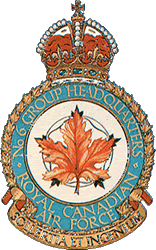
W/O2 A. Mather -- 424 Squadron
While on operations to Schweinfurt on February 24/25,1944, Halifax
III LW-438 coded QB-T flown by W/O2 A. Mather from 424 Squadron, was in
multiple combats with an ME-109 and an ME-110.
While outbound to the target they encountered a enemy aircraft identified by W/O Hayward, the rear gunner as an ME-109 at position 50:15N-01:25E at 20:29 while flying at 220 mph on a course of 147 degrees at 21,000 feet. Visibility was good, very clear with a slight moon and no clouds.
The enemy fighter was first sighted by the rear gunner attacking very steeply from below at 250 yards. This fighter carried no lights and no warning devices were carried on the Halifax. The rear gunner immediately instructed the pilot to corkscrew port and opened fire, no fire came from the fighter, after which the attack was broken off sharply on the port beam at 100 yards. The rear gunner ceased fire and gave the pilot instructions to resume course after completing one complete dive, roll, and climb. There was no searchlight activity in the immediate area and no hits were claimed on the fighter. The rear gunner fired 100 rounds with stoppages in three guns.
A little later another enemy aircraft was sighted by the rear gunner, identified as an ME-110 at position 50:03N-02:30E at 20:51 while flying at 220 mph on a course of 106 degrees at 21,000 feet. The weather conditions were the same. The enemy aircraft was first sighted by the rear gunner flying on the starboard quarter level at a range of 300 yards. This aircraft had navigation lights on and was committed to attack. The rear gunner immediately instructed the pilot to corkscrew starboard, the fighter attempted to follow, the rear gunner getting in bursts at the bottom of the first dive and at the top of the first climb. No return fire came from the fighter which gradually dropped back out of sight. No searchlight activity was seen but fighter flares which helped to show up the enemy fighter were seen. The rear gunner fired 200 rounds.
What seemed to be the same aircraft was again encountered at position
49:58N-02:35E at 20:57 while flying at 220 mph on a course of 106 degrees
at 21,000 feet. Weather conditions remained the same. The enemy aircraft
was first sighted by the rear gunner flying dead astern and slightly lower
at a range of 300 yards, definitely attacking and carrying navigation lights.
The rear gunner immediately ordered the pilot to corkscrew starboard and
opened fire. No return fire was experienced which followed in the corkscrew
and broke away to the starboard beam up, allowing Sgt Beilstein, the mid
upper gunner, to get in a burst, upon which the fighter immediately dived
steeply and leveled out well below and was lost from sight ahead. Fire
was ceased at a range of 100 yards. Course was resumed after six complete
corkscrews. No hits were claimed by the gunners. No searchlights in the
immediate vicinity but fighter flares were present. 450 rounds were fired
from the rear turret and 100 rounds from the mid upper turret.
![]()
![]()